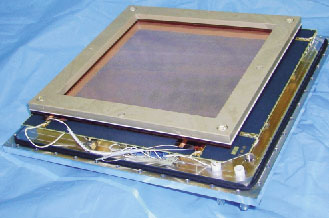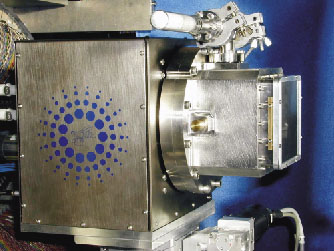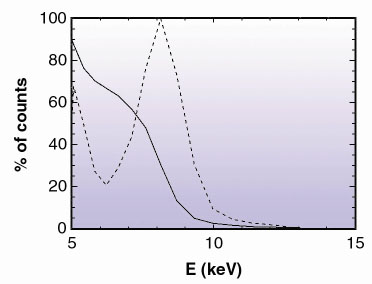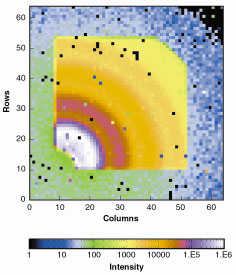Detector Development
With the continuous increase in source and optics performance, there is an ever increasing pressure to improve the detection capabilities. Therefore, a number of in-house and collaborative detector developments were undertaken during the last year. Some of these developments were concerned with improving or augmenting existing detectors, such as the gas filled detectors and the high speed CCDs, or FRELON cameras. Other developments concerned new detectors or detector technologies, such as the pixel detectors.
Gas-Filled Detector
Gas-filled detectors, with delay line detection, suffer from two main limitations. The first limitation is the local count rate. When a large number of photons hit the detector in a small area, many electron-ion pairs are created. Due to the relatively slow drift velocities of the ions, a local cloud of ions will form, and create a field screening effect, called space charge. This space charge significantly decreases the detector efficiency. The solution to this problem is to reduce the drift length of the ions and to neutralise them as quickly as possible. This is the principle of the gaseous electron multiplication (GEM) technology. In collaboration with CERN (group of F. Sauli) and within the scope of a European project named PASERO, GEM-foil-based X-ray detectors were developed. Sheets of 50 micrometre thick kapton were covered on both sides with a thin layer of Cu, and have 60 micrometre wide holes separated by 140 micrometres. Since the amplification process of electrons and ions happens within the small holes, the drift length of the ions is less than 50 micrometres, as compared to a few millimetres in classical gas-filled detectors. With this technology, we have now obtained an increase in local count-rate of two orders of magnitude. Figure 171 shows the inner part of a 200 mm by 200 mm detector with GEM technology that has been used successfully on the beamlines.
 |
Fig. 171: Inside view of the 200 mm by 200 mm gas filled detector utilising the new GEM technology. |
A second limitation of the gas-filled detectors, is the fact that all wires are read through a single readout port, called the delay line. While considerable progress has been made to speed up this process [1, 2], the real solution to the problem is to read all wires in parallel. Such a paralellisation is only possible by using Application Specific Integrated Circuits (ASIC). A first ASIC with 12 parallel channels has been designed, fabricated and successfully tested in the lab, and is now integrated within the GEM detector for the first beamline tests. We are currently developing a completely parallel readout structure based on ASIC's and Field Programmable Gate Arrays (FPGA). This will allow us to improve the total count rate by at least two orders of magnitude.
High Speed CCD FRELON Camera
CCD based detectors have become the workhorses of many synchrotron beamlines. However, due to the increased flux on the sample, the exposure times are often reduced to less than a second, whereas CCD readout times are typically a few seconds. To eliminate this mismatch, the ESRF has developed a Fast Readout Low Noise CCD camera, called FRELON. This camera has been used successfully on several beamlines for a number of years. To increase the speed, a 2000 x 2000 pixel version and a streaking mode of operation has been developed this year. In this mode only a few lines of the CCD are used for exposure and the rest of the lines serve as buffers. The streaking mode has been used successfully at ID17, the medical beamline. Furthermore, one camera has been coupled to a fibre optic taper, giving a 95 x 95 mm2 input field and a spatial resolution of 110 µm (full width at half maximum). It features an interchangeable phosphor mount for easy adaptation to various energies and resolutions. A picture of the fibre optic coupled camera is given in Figure 172.
 |
Fig. 172: FRELON 2000 x 2000 pixel camera coupled to a 95 mm by 95 mm input fibre optic taper. |
Pixel Detectors
Since August 2000, the ESRF has been a partner of the Medipix-2 collaboration. This is a collaboration of 15 European laboratories co-ordinated by CERN. Its goal is to produce a readout chip (ASIC) with 256 x 256 pixels of 55 µm pitch, as well as complete photon-counting pixel detector assemblies. Photon-counting pixel detectors distinguish themselves from CCD detectors by the fact that every pixel has its own data acquisition and processing electronics (amplifier, discriminator, counter). Since it is a counting detector, it has a certain energy resolution. Therefore, one can discriminate between X-ray signals and electronic noise and so virtually eliminate the noise.
 |
Fig. 173: Threshold scan of a MEDIPIX-1 assembly at ID10. The solid line gives the number of counts above a certain energy. The dash-dotted line is the derivative of the solid line and gives the number of counts at a certain energy. The 8.12 keV X-ray peak is clearly separated from the electronic noise. The energy resolution, |
Several beamline tests have already been done using the current chip version (Medipix-1 [3]) with 64 x 64 square pixels of 170 µm pitch bonded to a pixellated silicon sensor. The detector easily discriminates 8 keV X-rays from noise counts, as illustrated in Figure 173, and provides significant advantages in terms of spatial resolution and dynamic range when comparing with state-of-the-art CCD-based detectors. Figure 174 shows a small-angle scattering pattern obtained at ID10, showing an intensity range extending over five orders of magnitude above background. Another distinct advantage of the pixel detector is its possibility of fast readout. We have achieved acquisition rates of 100 Hz with the Medipix-1 chip at BM5 [4].
 |
Fig. 174: SAXS pattern of a SiO2 colloidal solution at 8.12 keV energy. The exposure time is 100 seconds. Only a few non-counting pixels (the black ones) can be seen. |
These results show that photon-counting pixel detectors have now reached an operational state, with performances surpassing those of current area detector systems.
References
[1] C. Herve, Nucl. Instr. and Meth. A, Accepted for publication.
[2] M.Kocsis, Nucl. Instr. and Meth. A 471, 103-108 (2001).
[3] M. Campbell et al., IEEE Transactions on Nuclear Science, 45, 751-753 (1998).
[4] C. Ponchut et al., Submitted to Nucl. Instr. and Meth. A.
Authors
H. Graafsma, M. Kocsis, C. Ponchut, C. Hervé and J.C. Labiche
ESRF



